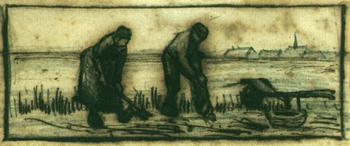
Potato Harvest with Two Figures

|
Potato Harvest is one of Van Gogh's simple, preliminary sketches. Interest in the piece stems from the story of its creation and its reflection of Van Gogh's social and moral ideology.
This sketch was prepared while Van Gogh lived in the town of Brabant. In the small shop where the artist bought his paints, he met a goldsmith who was moving into a new home. The goldsmith was an antiques collector and his new house was filled with antiques. The goldsmith wished to decorate the walls of the house with murals. He had already begun painting twelve panels and wanted to complete the work by adding images of various saints. Van Gogh, who felt a strong affinity and solidarity with the poor, convinced the antiques collector that painting images of the real lives of peasants would be more appealing and would have more impact than the presentation of saints. Van Gogh also suggested that these images of real people symbolize the four seasons. The goldsmith was enthusiastic about Van Gogh's ideas, but insisted on painting the panels himself. Van Gogh therefore prepared preliminary sketches of a sower, ploughman, shepherd, ox wagon and the potato diggers who are the subject of Potato Harvest.
Van Gogh spent a week in the fields studying and drawing potato harvesters as they worked. The preliminary sketch he prepared shows two potato diggers working in the foreground of an expansive field; farm houses can be seen on the horizon
Although this sketch was probably of little consequence to the artist, it is masterly. Van Gogh's skill in suggesting the attitudes of his figures with a few simple strokes of the pen, as well as his clear talent as a decorative artist, can be clearly seen in this work.












